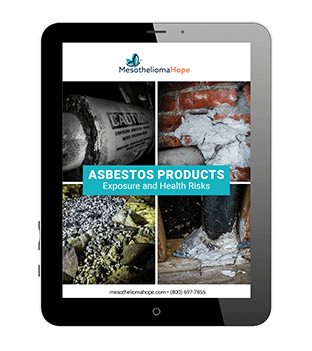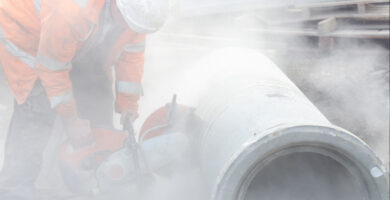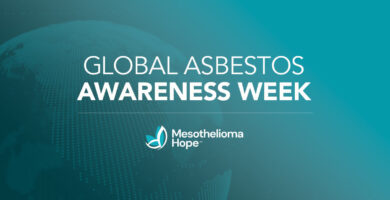Asbestos exposure is the leading cause of pleural (lung), peritoneal (abdomen) and pericardial (heart) mesothelioma. The deadly fiber was greatly used in commercial operations during World War II and since then, asbestos has been utilized in many industries. Workers in the following occupations have the riskiest jobs for asbestos exposure and need to be aware of necessary safety precautions.
1. Construction Workers
Due to its durability, asbestos was used in thousands of building materials throughout the 1900s. The vast majority of these materials have been banned and removed from general circulation. However, asbestos can still be found in some floor, roof and pipe materials.
Today, construction industry workers have one of the riskiest jobs for asbestos exposure when performing renovations.
Asbestos may be released into the air when older building materials are manipulated through drilling, sawing or sanding. If these fibrous particles are inhaled, internal damage can occur and present as mesothelioma in following years.
Employers are required to educate workers on which materials could contain asbestos before setting foot on a job site. As asbestos is still present in some building materials and site inspections do not always reveal all asbestos-containing materials (ACM), it’s important for construction workers to protect themselves through personal protection equipment (PPE).
2. Demolition Workers
Individuals who work within the demolition industry are commonly involved in the removal of older building materials and structures. Generally, buildings before 1980 contain over 3,000 asbestos-containing materials (ACM), from insulation and drywall to pipes and boilers.
As the building is dismantled, ACM can be disrupted and asbestos fibers into the air are released. Demolition workers are at risk of developing mesothelioma and other asbestos-related diseases if they breathe in these airborne fibers.
Employers have an obligation to protect their workers from asbestos exposure. If Project Managers are aware of ACM within the building, an asbestos specialist will be on site to ensure specific safety policies and procedures are followed throughout the operation. If asbestos is found during the demolition, professional asbestos removers will generally be contacted.
3. Automobile Mechanics
Cases of pleural mesothelioma have been reported across automobile mechanics and studies are pointing towards asbestos exposure as the main cause. Chrysotile asbestos has been used in automobile brake linings, clutches and gaskets for many years. The material’s ability to withstand extreme temperatures and fire made the fibrous material integral to the durability of these parts.
Automobile mechanics are at risk of being exposed to asbestos when working on new and old automobiles. The majority of asbestos-containing automobile materials were used in the 1960s and 70s, however, millions of these parts still remain in circulation and on vehicles.
As it is nearly impossible to tell if a particular part contains asbestos simply by looking at it, individuals within the industry should presume it does and proceed with caution. Asbestos fibers can be released into the air when manipulating materials through drilling, sanding, grinding and when cleaning brake lines using compressed air.
Professional automobile shops have an obligation to protect mechanics from asbestos exposure. Independent workers in the sector should be aware of their risks and protect themselves by using respirators and other respiratory protective equipment.
4. Firefighters
Along with construction, demolition and automobile workers, firefighting is also one of the riskiest jobs for asbestos exposure. Firefighters need to understand the proper safety precautions as they are likely to come into contact with the fibrous material on a frequent basis.
A study conducted in 2013 found that firefighters are twice as likely to develop mesothelioma when compared to the rest of the U.S. population. An additional study found that older firefighters are 159% more likely to develop the rare disease as they have had greater exposure to older buildings throughout their career.
If firefighters are dealing with an area that may contain asbestos, it is best practice to keep all protective equipment on. Masks, in particular, should never come off—especially when firefighters are taking off the rest of their gear. Firefighters are encouraged to wash themselves down (with gear on), as a lot of times the fibers will wash down and present less of an exposure threat.
If you work in any of the risky fields above, it is important to remember that employers have an obligation to protect you from asbestos exposure while at work. If you suspect your employer is not following the necessary asbestos safety procedures, you can contact our Justice Support Team to learn more about your rights.










